I grew up in a part of the Nebraska river bottom where black walnut trees (Juglans nigra) were abundant. I enjoyed picking the nut meat from the shells each year, after my grandmother ran the hard nuts over with her car in the driveway!
While I dreamt of each season’s bounty and Gram’s famous black walnut brownies, I didn’t know that these tasty nuts came with a price.
It wasn’t until my husband and I were well into the landscaping plans of our own 4-acre homestead that we started to notice trouble. Several of our newly-planted apple trees weren’t doing well.
While the cherries, pears, and plums thrived, these poor saplings were wilting, stunted, and sad.
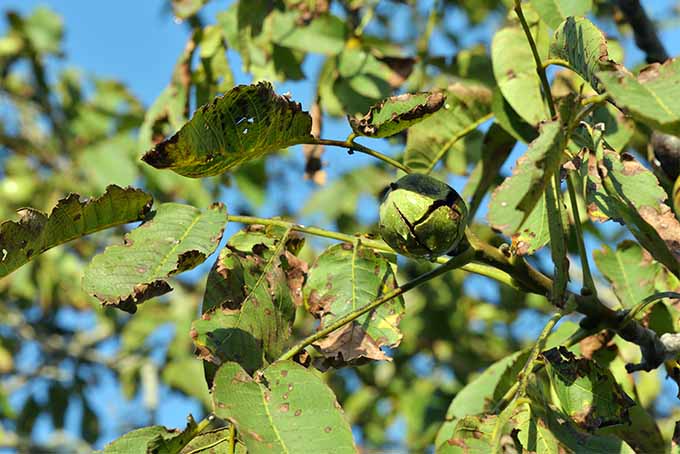
The adjacent property had a large walnut tree within 50 feet of our infant orchard. While I had occasionally admired the majestic stature of this tree (and secretly hoped for walnuts to fall on our side of the property line), I didn’t realize that my sudden tree deaths were related to its presence.
Though many I’ve talked to are unaware of its existence, black walnut trees utilize a special survival method that can be fatal to surrounding flora.
What Makes Black Walnuts Toxic?
A chemical known as juglone is the culprit here. Black walnuts aren’t the only trees that produce this no-nonsense defense system, composed of 5 hydroxy-1, 4- napthoquinone. Hickories (Carya) and butternuts (Juglans cinereal) are also to blame, but black walnut trees are known for having the highest concentrations of the stuff.
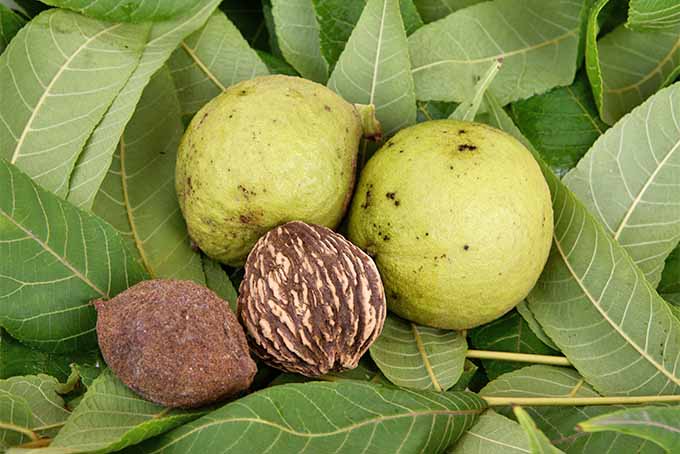
Juglone is released from virtually every part of the tree, although the roots, nuts, and seeds are the most toxic. This substance serves a purpose in ensuring the survival of the species, but surrounding plants are often subject to unwanted and undesirable consequences.
How Sensitive Plants React
At first glance, the juglone-sensitive plant may appear to be having other issues.
I know that I originally suspected my apple trees were suffering from other maladies. Cedar apple rust is very common here, and it can cause the leaves of apple trees to become mottled and frail.
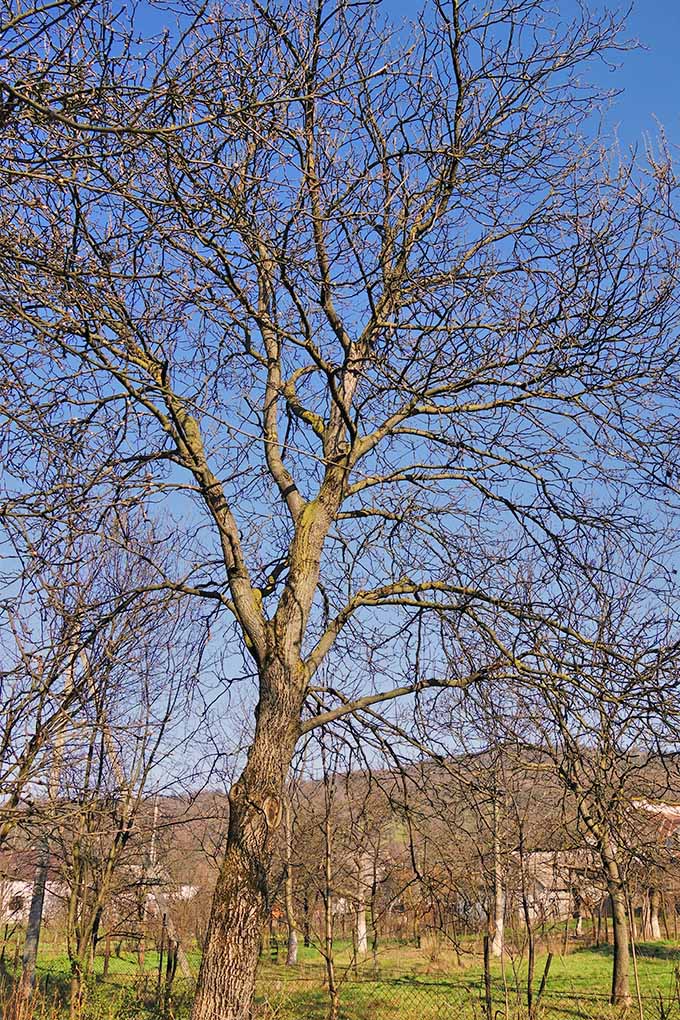
When trees started dying, however, I knew this was a cause for concern. Apples 40 feet away from the neighbor’s black walnut were in various stage of expiration. Only the trees growing outside the 60-foot marker, on the other side of our property, were thriving.
If you’re not familiar with the symptoms of juglone toxicity, you may also attribute it to something else.
According to the Morton Arboretum, your plants, trees, and shrubs may exhibit:
- Wilt
- Yellowing of leaves
- Stunted or slow growth
- Death – sometimes within a few months of exposure
There is no cure for juglone poisoning. The best thing you can do is avoid planting near black walnut trees!
Plants with a Chance of Survival
Not all plants are sensitive to the environment near the tree. But which ones are resistant? If you look at those that grow wild near volunteer juglone producers, you’ll have your answer!
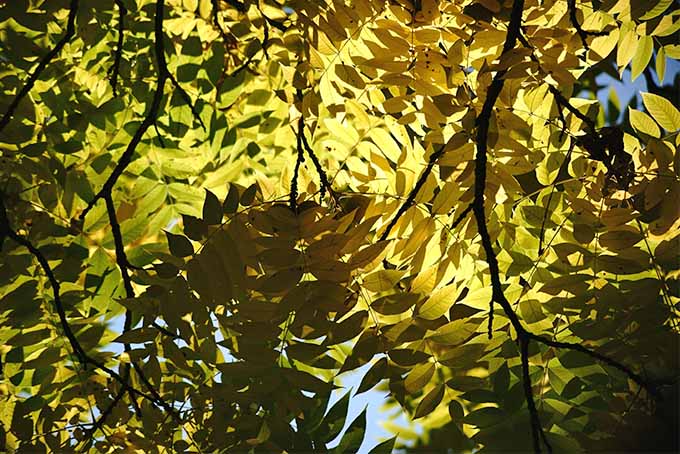
When I look outside at the natural, wooded areas of my childhood home, I see plenty of these thriving – often within a foot or two of the trees in question.
Tolerant Trees
Included in the “tolerant” category are the following trees:
- American Elm
- Black Cherry
- Dogwood (includes flowering)
- Eastern Red Cedar
- Hickory
- Locust (most types)
- Maple (except silver maple)
- Oak
- Ohio Buckeye
- River Birch
- Sycamore
- Virginia Pine
- Yellow Poplar
For the full list, see the Penn State Extension’s guide.
Tolerant Shrubs and Bushes
These shrubs have been identified as resistant to juglone in soil:
- American Holly
- Azalea (most types)
- Black Raspberry
- Currant
- Elderberry
- Juniper
- St. John’s Wort
- Snowball Hydrangea
- Sumac
- Witch Hazel
The rest of the list can be accessed via the link referenced above.
Tolerant Fruits and Vegetables
You’re safe to grow these around your black walnut tree:
- Beans
- Cherries
- Corn
- Melons
- Onions
- Quince
- Root vegetables (beets, carrots, parsnips)
- Squash
- Stone fruits (nectarines, peaches, plums)
Tolerant Flowers and Vines
The list of flowering plants that can handle being planted next to black walnut is rather long. Enjoy these blooming plants and vines without worry:
- Bee Balm
- Bleeding Heart
- Daffodil
- Chrysanthemum
- Crocus
- Hosta
- Iris
- Jack-in-the-Pulpit
- Jacob’s Ladder
- Jerusalem Artichoke
- Lamb’s Ear
- Morning Glory
- Pansy
- Pot Marigold
- Purple Coneflower
- Sunflower
- Tuberose
- Tulip
- Virginia Creeper
- Wild Grape
- Violet
- Yarrow
- Zinnia
Plus, there are dozens of others listed by the Penn State Extension.
Help for Established Gardens and Orchards
So, what if you are in the same situation as I was? What if you have established gardens or orchards, and cannot move the walnut or the affected plants? While success rates in mitigating the damage caused by juglone are low, there are some things you can try.
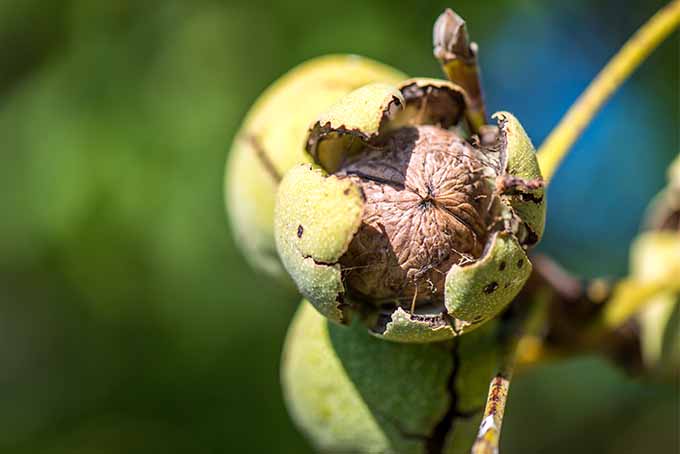
Start by ensuring that the seeds, leaves, and nuts of the walnut do not come into direct contact with your sensitive plants.
This may mean installing a protective balcony, fence, or other physical barrier that allows for sunlight and water to come through – but not toxic tree droppings.
In our case, bird netting did keep some of the larger debris that fell from the tree away from plants that were too fragile to be moved right away. If your plants are growing in soil directly above or near the roots of a walnut tree, you can try a raised bed system.
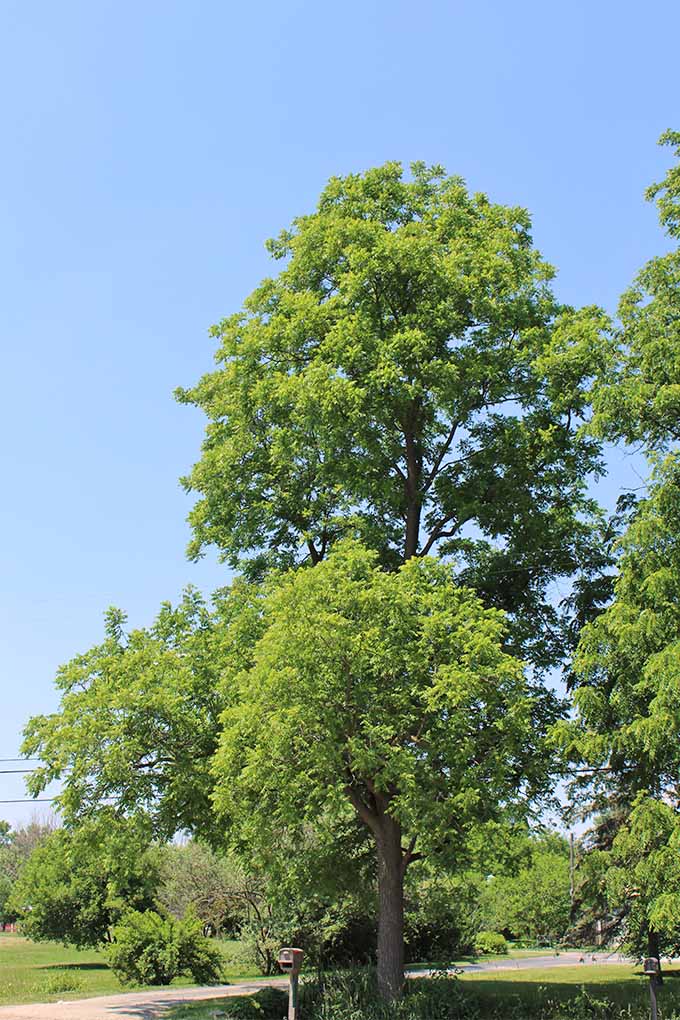
While this won’t work for trees or many shrubs, flowers and veggies can be put in a box or container with soil taken from elsewhere. Assuming there is a protective barrier from the soil placed underneath (nontoxic landscape cloth should work), you can keep your soil toxin-free.
One final tip is to keep soil well-drained and adequately watered. Flushing the toxins out of the soil can dilute their effects over time. But this is not a 100% guaranteed solution. The best plan is to keep plants outside of the 50-foot radius that is known to be harmful to them.
It’s also very important that you know where your fertilizer, compost, and mulch come from. Anything that may contain black walnut tree matter poses a risk.
Why Walnuts?
In light of all of this fuss, it may seem that it is just simpler to make sure you don’t have any of these trees on your property.
I strongly disagree with this sentiment. I grew up with these majestic trees providing wind protection, shade, and tasty nuts every year.
They have a long history of affecting the environment in a positive way, and I believe they should be accommodated, if possible.
On the other hand, not everyone has the space to allow for such a fickle tree.
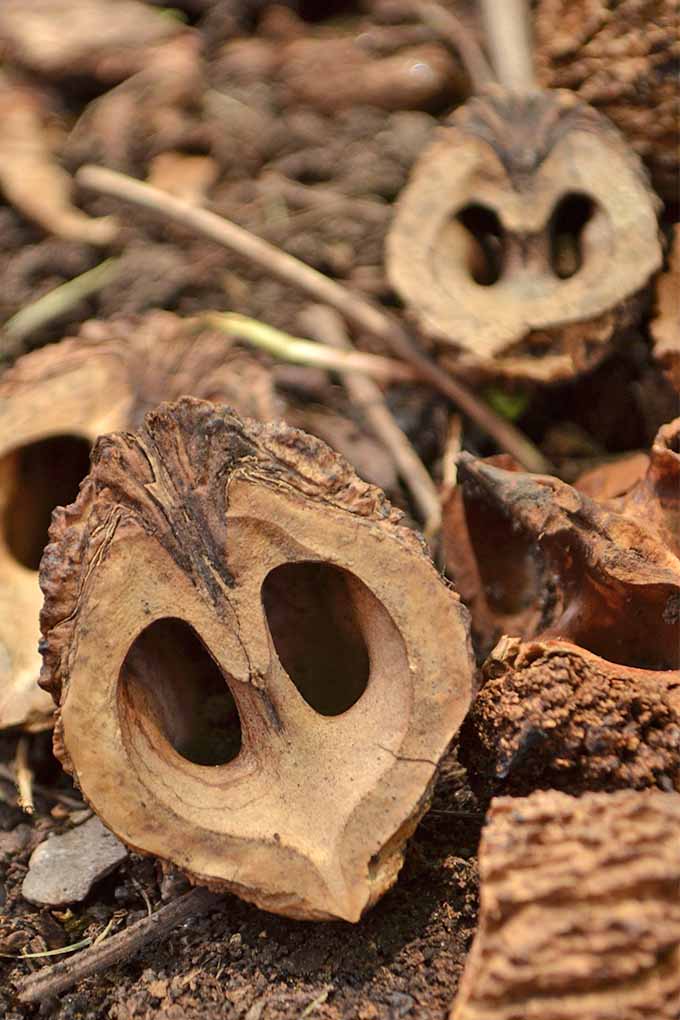
If your lot is particularly small, and you do decide that the tree has to go, be mindful of the roots. They can stay in the soil for years, continually releasing juglone into the surrounding area until they finally completely their decay process. Ridding yourself of the great walnut may not be the total solution you were looking for!
Do you have one of these trees in your yard or on your homestead? We’d love to hear about what you’ve done to create an ecosystem where both tree and garden can coexist.
Also, am I the only one with fond memories of shelling the hulls in the driveway? Share your black walnut memories in the comments.
© Ask the Experts, LLC. ALL RIGHTS RESERVED. See our TOS for more details. Uncredited photos: Shutterstock.
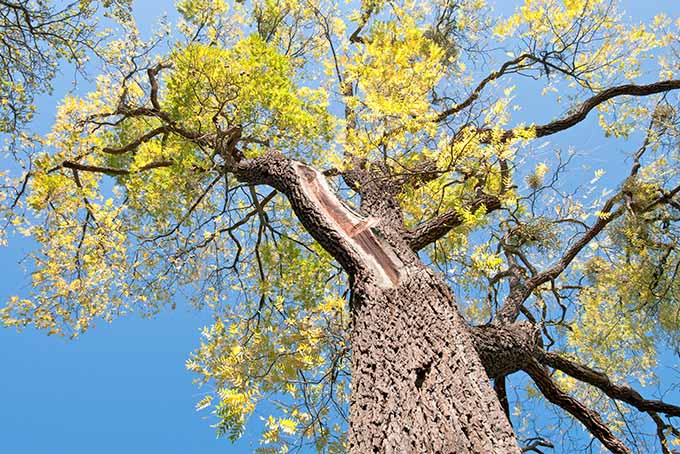
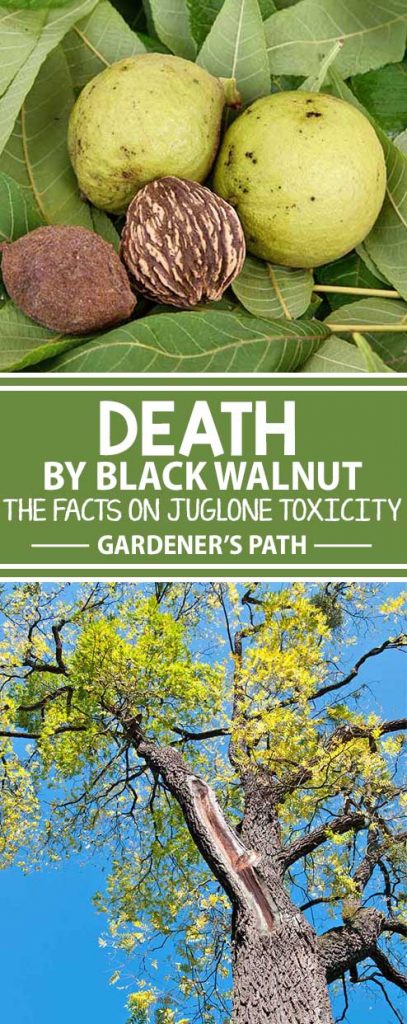
Thank you for spacing guidelines. I moved to the western North Carolina Mountains 4 years ago. Immediately, I planted a small orchard not realizing the beautiful 40′ tall tree about 60 ft away, just over the property line, was a Black Walnut. So far our two closest apple trees have been unaffected. My husband removed the BW limbs extending over the property line in order to reduce leaf and nut dropping. We are considering moving the young apple trees to a safer location. We have a BW on our acreage, too, about 20 ft from the vegetable garden. No problems… Read more »
Good luck to your and your apples, Linda! They are beautiful, though they can be messy. When I was growing up we had black walnuts within proximity of our vegetable garden too, as well as tall tulip poplars and other trees. Struggling to grow in what was mostly a shade garden seemed to be much more of an issue than any potential problems from juglone!
Planted 12 cedar trees along the rear property line — three on each end do good but the middle six are always dying. Then I was told it is because there is a Black Walnut tree just inside the neighbor’s property next to the cedar trees.
The end ones are over 8 ft tall and twice as big as the center six trees closest to the walnut trees. Does this sound like the reason for the failure of the centre trees?????
No fond memories here, just messes of staining leaves, staining nuts, dodging the falling hard nuts bombs, and sharp cracked shells that hurt your feet from my neighbor’s tree. They don’t belong in a city yard, especially on a property line.
My story involved a black walnut that sprouted in my neighbor’s yard. However, because it is growing in a corner where 4 backyards meet – a spot that affects my garden and my neighbor’s – my hands are tied. It is now too big to remove without professional help, which the owner has clearly refused to do. I’ve learned to grow crops that can survive near the walnut tree. My neighbor, on the other hand, is trying to raise his soil and water but I can see his tomatoes are all wilting. Eventually, he will learn like I did. Grow… Read more »
That is not the only option. You can kill it from your property which is ok where I live. I killed our neglectful neighbors walnut tree by severing the roots to my good soil and bought the wood for $200. His neglected tree comes down and I get a ton of walnut is a win win for me.
Thank you for this info. I also grew up in Indiana with a Grandma who would rake her walnuts into the driveway to help crack them. It is a delightful memory. I recently moved to where I live against a wild wooded area and there are a lot of walnut trees. A squirrel must have planted one directly on my property line because I just identified it and it is 5 ft + tall. It is in a bad spot and beginning to grow crooked, so I will be removing it, but this made me mindful of the other mature… Read more »
We have several acres of wooded land scattered with black walnut trees. There are a few along the edges of the woods where we get to enjoy the squirrels. It is quite comical to watch the squirrels bury their walnut, dig it back up, move to another spot and look around like they think another squirrel is watching and going to steal their treasured nut. The squirrels will do this for 30-40 minutes; digging and burying the walnut, then digging the nut up to move to another spot to bury it again. My grown children remember these entertaining events and… Read more »
Thanks for sharing, Suzanne! It’s excellent that you have enough space to enjoy both the squirrels and your garden. 🙂
5 a.m., 2/7/19, got my coffee, Youtube, and you. Problem solving: how do I turn a negative into a positive? I have 240,000 pounds of bw hulls, after becoming a huller for Hammons bw co, in ’17 and ’18. I hulled 40,000 pounds by myself in ’17, and in ’18 I got a partner who is retired, like me, and we hulled 80,000 pounds. Our goal this year is to do 160,000 pounds. Since the hulls weigh twice as much as the nut you can easily compute we will have 320,000 pounds of hulls from this year’s hulling. Luckily, my… Read more »
Wow, that is a lot of hulls, John! You’re absolutely correct that both hickory and pecan are tolerant since they both produce juglone as well, though in lesser concentrations than bw. As for including the aged hulls in compost for organic gardening, just be sure to keep in mind which plants are tolerant as well as the needs of your soil. Composted hulls are alkaline (sweet). Worm castings are always wonderful, and chicken manure is high in nitrogen and can be great for leafy plants, as long as it is aged. The fresh stuff tends to burn and cause damage,… Read more »
We have several black walnut trees in the yard and a few along the fence line out along the back 40. The squirrels love them, bury them, dig them, leave holes everywhere in the yard. The dog doesn’t like nearly getting hit in the head by a falling nut while watching the squirrels in the branches. We have run them over, busted them open with a vice, but we don’t really have a harvest. We have our taste and allow the rest to go to nature. I have a dogwood and a purple magnolia I want to plant near a… Read more »
They can be a nuisance, can’t they? I remember having to dodge the barrage from above as a kid, and then gathering them from the driveway with my brother for his experiments with making natural dye in buckets in the garage. When the trees are mature, those nuts fall from quite a height!
As for the lamium- how interesting! Lamium is usually regarded as a plant that does well within range of black walnut. Do you know if you had spotted deadnettle, or some other variety?
If I plant a black walnut tree in a pot, will the water run off from the pot contain juglone and kill my plants nearby?
I find this tread particularly interesting. It appears that Walnuts in addition to the trees resistant to this toxin appears to be some of the favorites to the Chinese Lantern Fly that has been invading parts of Pennsylvania.